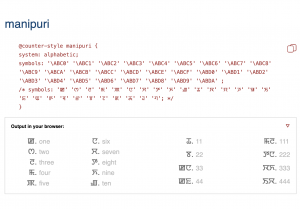Category: Update
Posts
Updated article: Typographic character units in complex scripts
The article “Typographic character units in complex scripts” was updated to reflect changes in grapheme cluster boundaries related to conjuncts in various scripts.
Updated: Ready-made Counter Styles
The Ready-made Counter Styles document provides ready-made definitions for counter styles and covers the needs of a range of cultures around the world. The code snippets provided in the document can be included in style declarations by simply copying and pasting, or they can be use as a starting point and modified as desired.
This update brings the total number of style templates to 177, covering 44 writing systems.
Substantial changes were also made to the styling and presentation. Each template is now accompanied by a set of examples, as well as an icon that copies the template to your clipboard in a single click. Another icon points to MDN’s roundup of browser support for named styles. Extensions to cover affix variants are now expressed in terms of the extends syntax.
Fixes were applied for tai-lue and warang-citi styles.
Finally, a button is provided to allow you to turn off all counter styling for the examples. That then allows you to see which styles have built-in support in the browser you are using.
Updated article: How to use Unicode controls for bidi text
The W3C Internationalization Activity has updated the article How to use Unicode controls for bidi text.
This article looks at how content authors can apply direction metadata to bidirectional text when markup is not available. It was largely rewritten to incorporate more up to date information and improve the examples.
Updated article: Normalization in HTML and CSS
The article Normalization in HTML and CSS was largely rewritten. It now describes the various normalization forms, and clarifies that W3C doesn’t require all content to be strictly NFC-normalized. It also warns about the dangers of blindly normalizing content to a particular normalization form (unless performing a match/sort procedure).
Translators are invited to update the translations in German, Spanish, French, Polish, Brazilian Portuguese, Russian, and Ukrainian.
Updated article: Styling vertical Chinese, Japanese, Korean and Mongolian text
The article Styling vertical Chinese, Japanese, Korean and Mongolian text has been updated in the following ways:
- The sections Sideways values of writing-mode and The sideways value of text-orientation have been rewritten to replace content with more up-to-date and accurate information.
- Browser support information has been overhauled and brought up to date.
- In-page live code has been added to show how each feature behaves in your browser.
Updated article: Languages using right-to-left scripts
The article “Script direction and languages” now has the title “What languages are written with right-to-left scripts?“, and provides insights into right-to-left (RTL) script usage around the world.
In a substantial revision, previous tables have been replaced with a completely new table which lists 12 scripts and over 200 languages using RTL scripts in the modern day. While it is only possible to give a rough idea of usage, the table includes information about which countries use those languages and figures for speakers of those languages. The data is gathered from the SIL Ethnologue.
New additions to the “About Internationalization” page
New sections, “What is internationalization” and “What the W3C Internationalization Activity does” have been added to the W3C I18n Activity’s “About internationalization” page.
The page is now also available in Chinese.
Updated article: Approaches to full justification
This article gives a high level summary of various typographic strategies for fully justifying text on a line and in a paragraph for a variety of scripts, and offers some advice to authors and implementers.
The section about SE Asian justification was rewritten as South & Southeast Asian Writing Systems, adding more detail, and shows examples for Tamil of inter-glyph stretching (as opposed to inter-character).
Updated article: Declaring language in HTML
An update for the article Declaring language in HTML has just been published.
This page describes how to mark up an HTML page so that it gives information about the language of the page. It begins with an overall summary, then provides additional details in subsequent sections.
The material was reorganised to expand the quick answer section and de-emphasise the information about XML/XHTML declarations.
Updated/new articles: Working with RTL scripts in HTML
The following two related articles have been updated, and one new article is published.
Structural markup and right-to-left text in HTML looks at ways of handling text direction for structural markup in HTML, ie. at the document level and for elements like paragraphs, tables and forms. The article has been largely rewritten to take into account recent developments in HTML and CSS. A section was added to describe the use of logical properties. The text was made more concise.
Inline markup and bidirectional text in HTML tells you how to write HTML where text with different writing directions is mixed within a paragraph or other HTML block (ie. inline or phrasal content).
Inline bidi markup examples now contains the worked examples and the descriptions of markup that were previously in the inline bidi article. This and various small edits, including a new set of examples with links to live versions, are intended to make it easier to read the main article and make its advice clearer.
W3C® liability, trademark and permissive license rules apply.
Questions or comments? xfq@w3.org


